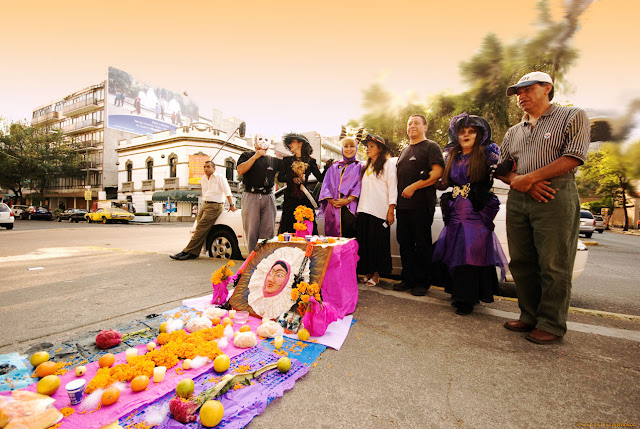
 Shop window of a candy store.
Shop window of a candy store.
The Day of The Dead
Her face is unforgettable and she goes by many names: La Catrina, la Flaca, la Huesuda, la Pelona--Fancy Lady, Skinny, Bony, Baldy. A fixture in Mexican society, she's not some trendy fashion model, but La Muerte--Death.
Renowned writer Octavio Paz observes that, undaunted by death, the Mexican has no qualms about getting up close and personal with death, noting that he "...chases after it, mocks it, courts it, hugs it, sleeps with it; it is his favorite plaything and his most lasting love."
November 1, All Saints Day, and November 2, All Souls Day are marked throughout Mexico by a plethora of intriguing customs that vary widely according to the ethnic roots of each region. Common to all, however, are colorful adornments and lively reunions at family burial plots, the preparation of special foods, offerings laid out for the departed on commemorative altars and religious rites that are likely to include noisy fireworks.
In most localities November 1 is set aside for remembrance of deceased infants and children, often referred to as angelitos (little angels). Those who have died as adults are honored November 2.
From mid-October through the first week of November, markets and shops all over Mexico are replete with the special accouterments for the Dia de Muertos (Day of the Dead). These include all manner of skeletons and other macabre toys; intricate tissue paper cut-outs called papel picado; elaborate wreaths and crosses decorated with paper or silk flowers; candles and votive lights; and fresh seasonal flowers, particularly cempazuchiles (marigolds) and barro de obispo (cockscomb). Among the edible goodies offered are skulls, coffins and the like made from sugar, chocolate or amaranth seeds and special baked goods, notably sugary sweet rolls called pan de muerto that come in various sizes invariably topped with bits of dough shaped like bones and, in some regions, unadorned dark breads molded into humanoid figures called animas (souls). All of these goods are destined for the buyer's ofrenda de muertos (offering to the dead).
Copyright 1995 by Dale Palfrey. All rights reserved.
http://www.mexconnect.com/mex_/feature/daydeadindex.html


























